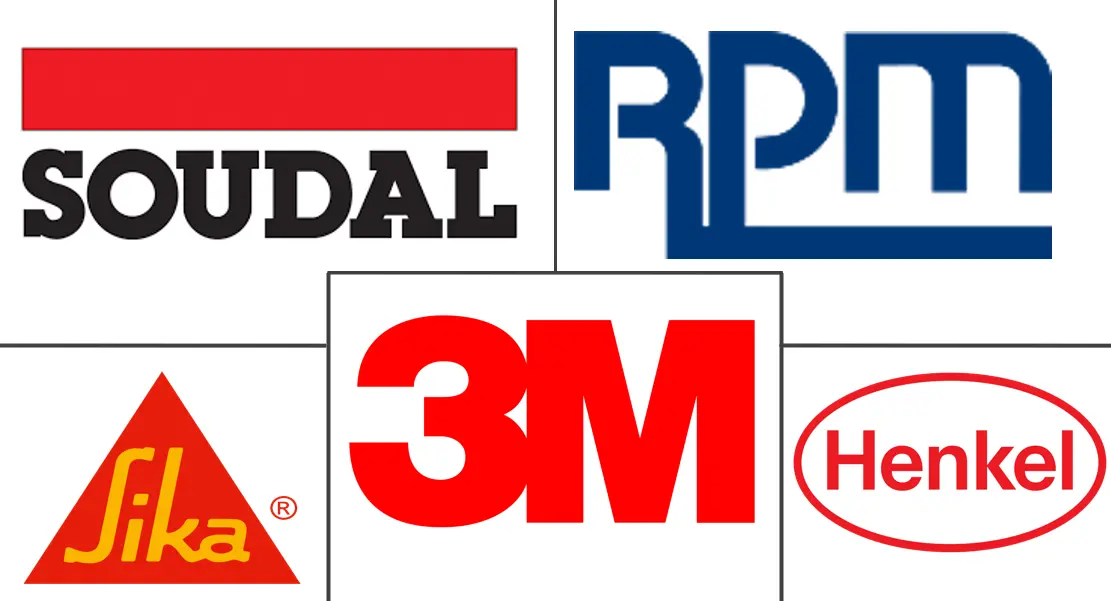Market Size of Asia-Pacific Sealants Industry

| Study Period | 2019 - 2029 |
| Base Year For Estimation | 2023 |
| Forecast Data Period | 2024 - 2029 |
| Historical Data Period | 2019 - 2022 |
| CAGR | > 6.50 % |
| Market Concentration | Low |
Major Players
*Disclaimer: Major Players sorted in no particular order |
Asia-Pacific Sealants Market Analysis
The Asia-Pacific sealants market is estimated to be valued at more than USD 3,800 million by the end of the year, and it is expected to register an estimated CAGR of over 6.5% over the forecast period.
The region was negatively affected by the COVID-19 pandemic. The sealant market in the region also faced a similar situation. But the market has now reached pre-pandemic levels, and it is expected to grow steadily.
- The demand for sealants is extensively driven by the growing demand from the construction industry and the increasing usage for healthcare applications in the ASEAN region.
- But the growth is likely to be slowed down by the strict rules about sealants and VOC emissions.
- The innovation and development of bio-based sealants and their rising usage in the aerospace industry are likely to offer opportunities for the Asia-Pacific sealants market.
- China stands to be the largest market for adhesives in the region, where consumption is driven by end-user industries such as automotive, construction, healthcare, and aerospace.
Asia-Pacific Sealants Industry Segmentation
Sealants are used to form a hard coating on a porous surface. These are generally used to fill gaps between substrates and have properties including adhesion, corrosion resistance, and insolubility. The Asia-Pacific Sealants Market is segmented by end-user industry, resin, and region. On the basis of the end-user industries, the market is segmented into aerospace, automotive, building and construction, healthcare, and other end-user industries. By "resin," the market is segmented into acrylic, epoxy, polyurethane, silicone, and other resins. By geography, the market is segmented into Australia, China, India, Indonesia, Japan, Malaysia, Singapore, South Korea, Thailand, and the Rest of Asia-Pacific. The report offers market sizes and forecasts in revenue (USD million) and volume (kilo tons) for all the above segments. The report also covers the market size and forecasts for the market in nine countries across the region.
| End-user Industry | |
| Aerospace | |
| Automotive | |
| Building and Construction | |
| Healthcare | |
| Other End-user Industries |
| By Resin | |
| Acrylic | |
| Epoxy | |
| Polyurethane | |
| Silicone | |
| Other Resins |
| Geography | |
| Australia | |
| China | |
| India | |
| Indonesia | |
| Japan | |
| Malaysia | |
| Singapore | |
| South Korea | |
| Thailand | |
| Rest of Asia-Pacific |
Asia-Pacific Sealants Market Size Summary
The Asia-Pacific sealants market is poised for steady growth, having rebounded to pre-pandemic levels after the disruptions caused by COVID-19. The market's expansion is primarily fueled by the burgeoning construction industry and the increasing application of sealants in healthcare within the ASEAN region. However, the growth trajectory faces challenges due to stringent regulations concerning sealants and VOC emissions. Innovations in bio-based sealants and their growing adoption in the aerospace sector present new opportunities for market players. China emerges as the largest consumer of sealants in the region, driven by its robust automotive, construction, healthcare, and aerospace industries. The demand for construction sealants is particularly high, with silicone sealants dominating the market due to their resilience against extreme weather conditions.
The building and construction sector is the largest consumer of sealants in several Asia-Pacific countries, including China, India, and Indonesia, with significant investments in infrastructure projects. The pandemic-induced surge in healthcare facility demands has also spurred the use of sealants in medical technology development, particularly in Malaysia, where the government is actively promoting the medical device manufacturing sector. As trade exchanges resume and production facilities operate at full capacity, the demand for healthcare sealants is expected to rise. The market is characterized by healthy competition, with major players like 3M, Sika AG, Henkel AG & Co. KGaA, Soudal Holding N.V., and RPM International Inc. actively expanding their presence in the region.
Asia-Pacific Sealants Market Size - Table of Contents
-
1. MARKET DYNAMICS
-
1.1 Drivers
-
1.1.1 Increasing Construction Activities in Asia-Pacific
-
1.1.2 Rising demand for Healthcare Applications in ASEAN region
-
-
1.2 Restraints
-
1.2.1 Stringent Environmental Regulations Regarding VOC Emissions
-
1.2.2 Other Restraints
-
-
1.3 Industry Value-chain Analysis
-
1.4 Porter's Five Forces Analysis
-
1.4.1 Bargaining Power of Suppliers
-
1.4.2 Bargaining Power of Consumers
-
1.4.3 Threat of New Entrants
-
1.4.4 Threat of Substitute Products and Services
-
1.4.5 Degree of Competition
-
-
1.5 Regulations
-
-
2. MARKET SEGMENTATION (Market Size in Value and Volume)
-
2.1 End-user Industry
-
2.1.1 Aerospace
-
2.1.2 Automotive
-
2.1.3 Building and Construction
-
2.1.4 Healthcare
-
2.1.5 Other End-user Industries
-
-
2.2 By Resin
-
2.2.1 Acrylic
-
2.2.2 Epoxy
-
2.2.3 Polyurethane
-
2.2.4 Silicone
-
2.2.5 Other Resins
-
-
2.3 Geography
-
2.3.1 Australia
-
2.3.2 China
-
2.3.3 India
-
2.3.4 Indonesia
-
2.3.5 Japan
-
2.3.6 Malaysia
-
2.3.7 Singapore
-
2.3.8 South Korea
-
2.3.9 Thailand
-
2.3.10 Rest of Asia-Pacific
-
-
Asia-Pacific Sealants Market Size FAQs
What is the current Asia-Pacific Sealants Market size?
The Asia-Pacific Sealants Market is projected to register a CAGR of greater than 6.5% during the forecast period (2024-2029)
Who are the key players in Asia-Pacific Sealants Market?
3M, Sika AG, Henkel AG & Co. KGaA, Soudal Holding N.V. and RPM International Inc. are the major companies operating in the Asia-Pacific Sealants Market.

